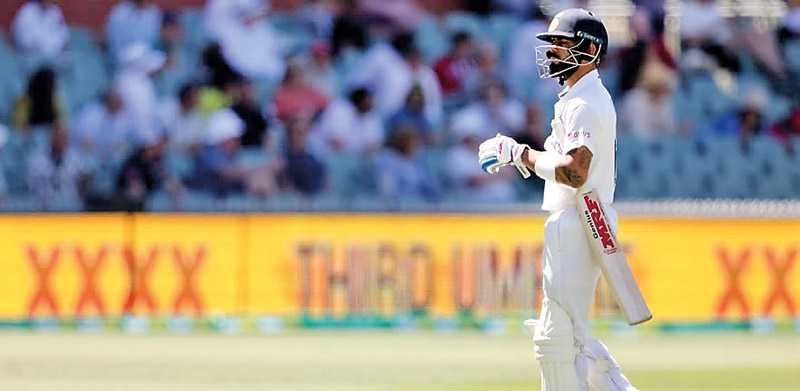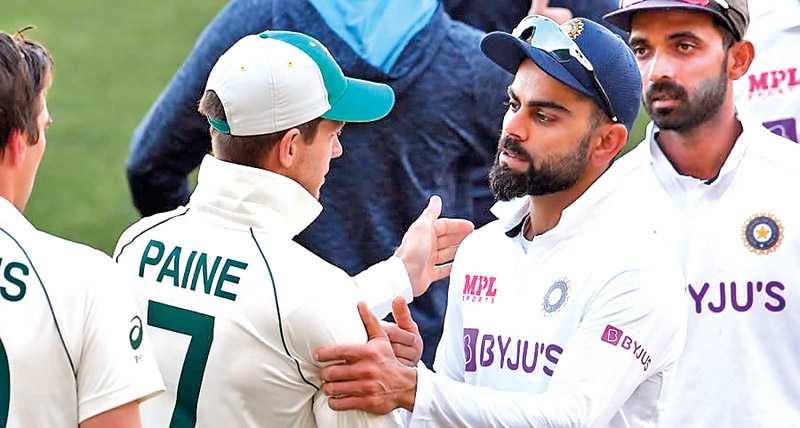Friday Mar 28, 2025
Friday Mar 28, 2025
Monday, 21 December 2020 00:18 - - {{hitsCtrl.values.hits}}

India bat in the dying moments of their horror innings against Australia - AFP/Getty Images
The inquisitions will come, but the truth is there is not a lot India could have done in the face of flawless fast bowling
ESPNCRICINFO: There is a reason why batsmen are treated as the favoured children in cricket, and it can be easy to forget that in an era dominated by limited-overs cricket.
Test batting is a fickle occupation. It turns many of its practitioners to compulsive behaviour, which can be loosely defined as feeling compelled to do things that you know have no bearing on your pursuit but somehow make you feel they help you control the outcome. Some carry a particular-coloured kerchief, some put a specific pad on first, some make sure toilet seats in the change rooms are up when they are batting, the list is endless.
That’s because there are so many loose ends in Test batting that you can’t possibly control them all with your skill, technique and preparation. Watching Test cricket on demanding pitches, it is hard to imagine a batsman who is neither a philosopher nor insane.
There is just not enough space in the scorebook to say “nought, but got the first shooter of the match”, or “15 but fell to one that swung one way in the air and nipped the other way after pitching”. Or even, “135 but dropped five times”, or “75 but it was predominantly a slog”.
At the end of the day, staring you in the face are cold numbers with their absolute finality. It is hard to find a trade that is less unequivocal and yet has such an unforgiving currency.
And the cold numbers will forever remain 36 all out. Scores of 4, 9, 2, 0, 4, 0, 8, 4, 0, 4, 1. Terms such as “humiliated” and “embarrassed” will be used. There will be an obvious inquest into the techniques of the batsmen, into their preparation, even chauvinistically into other virtues such as courage, but perhaps there is a simpler explanation.
Virat Kohli himself spoke of a lack of intent, but he is a proud participant of a Test match that was in his grasp. Not just any Test but a Test that Australia have never lost: the day-night fixture. He perhaps felt that if India had been more positive and had scored a quick 20-30 runs in the morning, that would have deflated Australia.
However, the intent or the technique was not too different to how it has always been. Even in the last Adelaide Test, which India won, they capitalised on their 15-run first-innings lead with Cheteshwar Pujara and Ajinkya Rahane batting at strike rates of 34 and 47. In terms of technique, pretty much everyone batted similarly to how they batted in the first innings for a lead of 53 runs.
However, a few things happened that were not in the control of these batsmen, and proud competitors are loathe to admitting they couldn’t have done anything about it. What happened in the first session of the third day is the textbook definition of a perfect storm. The ball actually seamed less than it did in any of the sessions before this, which is what Kohli acknowledged but to say that his batsmen should have done better. Less movement meant more balls hit the edge than beat it.
Usually in Test cricket, it takes a little over 10 balls of not being in control for a batsman to lose a wicket to a bowler. In this innings, India lost nine of them by not being in control only 32 times. Since the start of 2010, only once has a team’s bowlers taken nine wickets in an innings with fewer mistakes made by batsmen. That is true of all such spectacular collapses. When Australia were bowled out for 60 at Trent Bridge in 2015, they were not in control only 40 times. The number was the same in their 47 all out at Newlands in 2011-12. Fewer plays and misses, more nicks.
It is also true that such spectacular collapses happen against exceptional bowling sides who have been at it for long and suddenly reap the rewards in a bunch. And this Australian attack is an exceptional one with three fast bowlers with three different skillsets and a high rate of accuracy, followed by an all-time-great spinner, but even they will be the first ones to admit they didn’t bowl much better than they did two days ago.
Josh Hazlewood, who took five wickets for eight runs, was too stunned to explain what happened. He compared this to the time they bowled England out for 67. The bowlers, he said, didn’t do much differently: perhaps a touch fuller, perhaps a touch straighter. Those are his words.
So the ball is moving just the right amount to take the edge, the length is just full enough to let it move without letting the batsmen drive, the bounce is steep thus keeping the batsmen stuck to the crease, and the last piece of the jigsaw is the quickening of the pitch from day one, giving you less time to adjust and also carrying the edges to hand. The proverbial “one of those sessions”, but one that has left the magnifying glass on the batsmen.
Replay after replay will show you the batsmen stuck on the crease when edging in this innings, but not the countless number times when they drove for boundaries with the same technique. Or even the edges that didn’t carry as recently as two days ago. Or the plays and misses that now became nicks. This is what happens at the start of most innings. On most days you make your early errors and make the correction. On this day, your first error was your last. People will ask questions of Kohli’s drive away from the body, but on flat pitches, in this scenario, you had to capitalise on any width you got, rare as it was.
Of course, if there are technical flaws, they need to be addressed. In New Zealand, when Prithvi Shaw’s lack of foot movement was exploited in the first Test, he had corrected himself by the second, getting closer to the ball when driving in his 64-ball 54. Shaw will be the first one to want to correct it again. Questions need to be asked, for example, why India repeatedly fail to get the better of overseas spinners in their conditions even keeping in mind the pressure that is created by their seamers. Coach Ravi Shastri knows he will be judged by these improvements, the growth of the players, and not just by the results produced by an amazingly talented group of players.
Of course, there will also be schadenfreude around the world, which Shastri and the team will know comes with the territory if you deal in unfounded bluster and run down your own country’s legends to try to talk your current team up without acknowledging the dominance you enjoy now in terms of resources and finances. This is the day Shoaib Akhtar will not be the only one to tell them to “bear it, bear the criticism, this is gonna happen to you now.”
However, this might be the day to listen to Sunil Gavaskar instead, who has been accused of firing blanks when criticising the team in the past and might have had reason to be opportunistic now. Gavaskar, though, knows batting too well to ignore what happened.
“Any team that gets out for its lowest-ever total, it is never good to see,” Gavaskar told 7Cricket. “Having said that, most other teams, if they had been facing that kind of bowling, they would have also got into trouble. Maybe not all out for 36, maybe 72 or maybe 80-90, but the way Hazlewood, Cummins bowled, and the earlier spell of Starc, that asked a lot of questions. So it is not fair to blame the Indian batsmen for the way they got out because it was just simply superb by the Australians. Most of the teams would have struggled.”
If ever there was need for bluster, to talk the players out of the misery they will no doubt be in, also keeping in mind how long they have been on the road and in biosecure bubbles, it is now.

Virat Kohli walks back, the key wicket in the middle of an India collapse - Getty Images

Tim Paine and Virat Kohli catch up after the game - Getty Images

Discover Kapruka, the leading online shopping platform in Sri Lanka, where you can conveniently send Gifts and Flowers to your loved ones for any event including Valentine ’s Day. Explore a wide range of popular Shopping Categories on Kapruka, including Toys, Groceries, Electronics, Birthday Cakes, Fruits, Chocolates, Flower Bouquets, Clothing, Watches, Lingerie, Gift Sets and Jewellery. Also if you’re interested in selling with Kapruka, Partner Central by Kapruka is the best solution to start with. Moreover, through Kapruka Global Shop, you can also enjoy the convenience of purchasing products from renowned platforms like Amazon and eBay and have them delivered to Sri Lanka.
Discover Kapruka, the leading online shopping platform in Sri Lanka, where you can conveniently send Gifts and Flowers to your loved ones for any event including Valentine ’s Day. Explore a wide range of popular Shopping Categories on Kapruka, including Toys, Groceries, Electronics, Birthday Cakes, Fruits, Chocolates, Flower Bouquets, Clothing, Watches, Lingerie, Gift Sets and Jewellery. Also if you’re interested in selling with Kapruka, Partner Central by Kapruka is the best solution to start with. Moreover, through Kapruka Global Shop, you can also enjoy the convenience of purchasing products from renowned platforms like Amazon and eBay and have them delivered to Sri Lanka.